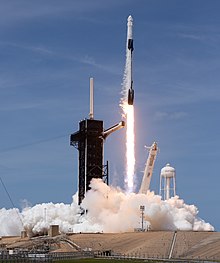Falcon 9
 | |
 | |
| Function | Orbital launch vehicle |
|---|---|
| 生產商 | SpaceX |
| Sán-tōe | United States |
| Cost per launch | |
| Size | |
| 高度 | |
| 直徑 | 3.7 m (12 ft)[3] |
| 質量 | |
| Stages | 2 |
| Capacity | |
| Payload to Low Earth orbit (LEO) | |
| 軌道傾角 | 28.5° |
| 質量 | |
| Payload to Geosynchronous transfer orbit (GTO) | |
| 軌道傾角 | 27.0° |
| 質量 | |
| Payload to Mars transfer orbit | |
| 質量 | FT: 4 t (8,800 lb)[1] |
| Associated rockets | |
| 衍生作品 | Falcon Heavy |
| Launch history | |
| Status |
|
| Launch sites | |
| Total launches |
|
| Success(es) |
|
| Failure(s) |
1 (v1.1: CRS-7 in-flight) |
| Partial failure(s) | 1 (v1.0: CRS-1)[9] |
| Notable outcome(s) | 1 (FT: AMOS-6 pre-flight destruction) |
| Landings | / attempts |
| First flight |
|
| Last flight |
|
| First stage | |
| 發動機 | |
| 最大推力 | |
| Specific impulse | |
| Burn time | |
| Propellant | LOX / RP-1 |
| Second stage | |
| 發動機 |
|
| 最大推力 | |
| Specific impulse | |
| Burn time | |
| Propellant | LOX / RP-1 |
Falcon 9 sī chi̍t lūi nn̄g-tōaⁿ-sek hoat-siā ūn-kū (launch vehicle), sú-iōng káu lia̍p tē-it kai-tōaⁿ ian-jín, seng-sán kiam siat-kè-chiá sī SpaceX kong-si. 2015 nî té í-āu hông sú-iōng ê khoán-sek sī Falcon 9 Full Thrust.
Falcon 9 hē-thóng ê tē-it tōaⁿ thang têng-ho̍k sú-iōng; siang kai-tōaⁿ lóng tàu lī-ēng e̍k-thé sng-sò͘ kap RP-1 jiân-liāu thui-sak ê hóe-chìⁿ ian-jín.
Tsù-kái[siu-kái | kái goân-sí-bé]
- ↑ 1.0 1.1 1.2 1.3 Ín-iōng chhò-gō͘: Bû-hāu ê
<ref>tag; chhōe bô chí-miâ ê ref bûn-jīspacex-capabilities - ↑ "SpaceX targets 2021 commercial Starship launch". 28 June 2019. goân-loē-iông tī 28 August 2019 hőng khó͘-pih. 30 June 2019 khòaⁿ--ê. Unknown parameter
|url-status=ignored (help) - ↑ 3.0 3.1 3.2 3.3 3.4 3.5 3.6 3.7 Ín-iōng chhò-gō͘: Bû-hāu ê
<ref>tag; chhōe bô chí-miâ ê ref bûn-jīfalcon9-2015 - ↑ 4.0 4.1 4.2 4.3 4.4 4.5 4.6 4.7 4.8 Ín-iōng chhò-gō͘: Bû-hāu ê
<ref>tag; chhōe bô chí-miâ ê ref bûn-jīfalcon9-2013 - ↑ 5.0 5.1 5.2 5.3 5.4 5.5 5.6 5.7 5.8 Ín-iōng chhò-gō͘: Bû-hāu ê
<ref>tag; chhōe bô chí-miâ ê ref bûn-jīfalcon9-2010 - ↑ Clark, Stephen. "SpaceX launch sets record for Falcon 9 payload mass – Spaceflight Now". Spaceflight Now / Pole Star Publications Ltd. 28 August 2022 khòaⁿ--ê.
- ↑ "Air Force requirements will keep SpaceX from landing Falcon 9 booster after GPS launch". Spaceflight Now. goân-loē-iông tī 20 May 2019 hőng khó͘-pih. 17 May 2019 khòaⁿ--ê. Unknown parameter
|url-status=ignored (help) - ↑ Seemangal, Robin (4 May 2018). "SpaceX Test-Fires New Falcon 9 Block 5 Rocket Ahead of Maiden Flight (Updated)". Popular Mechanics. goân-loē-iông tī 7 April 2019 hőng khó͘-pih. 2 February 2019 khòaⁿ--ê. Unknown parameter
|url-status=ignored (help) - ↑ de Selding, Peter B. (15 October 2012). "Orbcomm Craft Launched by Falcon 9 Falls out of Orbit". Space News. goân-loē-iông tī 12 May 2015 hőng khó͘-pih. 15 October 2012 khòaⁿ--ê.
Orbcomm requested that SpaceX carry one of their small satellites (weighing a few hundred pounds, versus Dragon at over 12,000 pounds)... The higher the orbit, the more test data [Orbcomm] can gather, so they requested that we attempt to restart and raise altitude. NASA agreed to allow that, but only on condition that there be substantial propellant reserves, since the orbit would be close to the International Space Station. It is important to appreciate that Orbcomm understood from the beginning that the orbit-raising maneuver was tentative. They accepted that there was a high risk of their satellite remaining at the Dragon insertion orbit...
Unknown parameter|url-status=ignored (help) - ↑ Graham, William (21 December 2015). "SpaceX returns to flight with OG2, nails historic core return". NASASpaceFlight. goân-loē-iông tī 22 December 2015 hőng khó͘-pih. 22 December 2015 khòaⁿ--ê.
The launch also marked the first flight of the Falcon 9 Full Thrust, internally known only as the "Upgraded Falcon 9"
Unknown parameter|url-status=ignored (help) - ↑ Graham, Will (29 September 2013). "SpaceX successfully launches debut Falcon 9 v1.1". NASASpaceFlight. goân-loē-iông tī 29 September 2013 hőng khó͘-pih. 29 September 2013 khòaⁿ--ê. Unknown parameter
|url-status=ignored (help) - ↑ Ín-iōng chhò-gō͘: Bû-hāu ê
<ref>tag; chhōe bô chí-miâ ê ref bûn-jīMSDB - ↑ Ín-iōng chhò-gō͘: Bû-hāu ê
<ref>tag; chhōe bô chí-miâ ê ref bûn-jīfalcon9-2016 - ↑ 14.0 14.1 "Falcon 9". SpaceX. 16 November 2012. goân-loē-iông tī 1 May 2013 hőng khó͘-pih. 29 September 2013 khòaⁿ--ê.
- ↑ Ín-iōng chhò-gō͘: Bû-hāu ê
<ref>tag; chhōe bô chí-miâ ê ref bûn-jīSpaceX March 10, 2009
| Pún bûn-chiuⁿ sī chi̍t phiⁿ phí-á-kiáⁿ. Lí thang tàu khok-chhiong lâi pang-chō͘ Wikipedia. |
